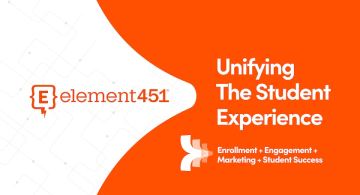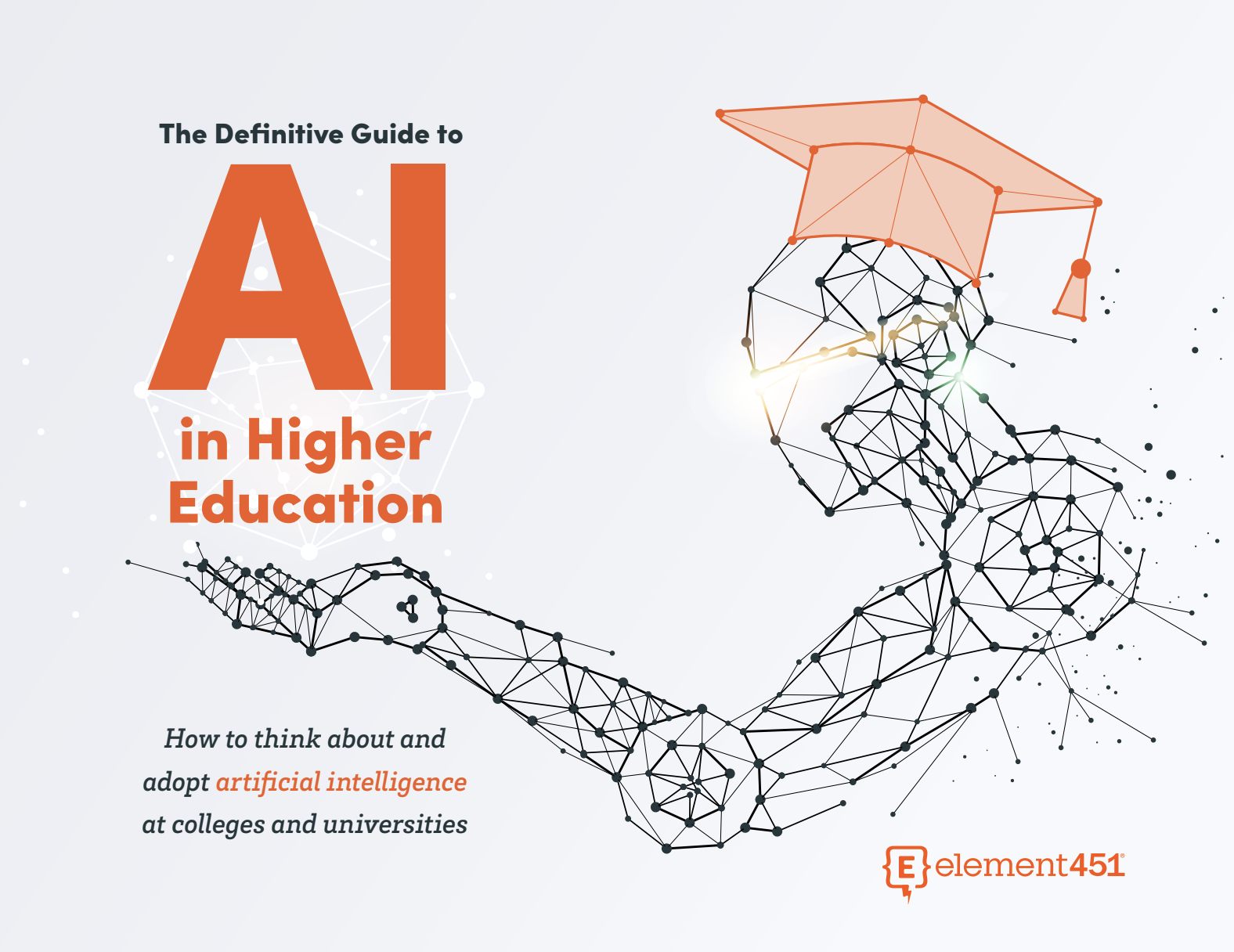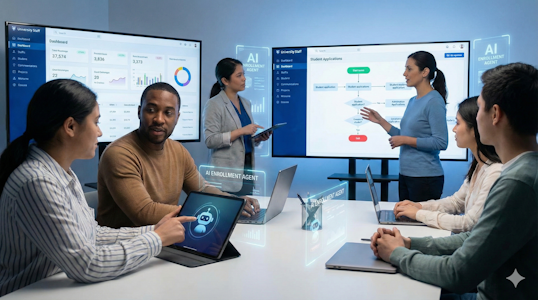Building and Retaining Student, Staff, and Faculty Engagement Upon Returning to Campus with CSU East Bay President Cathy Sandeen
by Sirley Carballo · Oct 25, 2021

Cathy Sandeen, President of California State University - East Bay joins Eric Stoller on our latest episode of the In Your Element Podcast, for a fascinating talk. In this deep dive chat, Eric and Cathy discuss how the events of 2020 changed the ways in which higher ed thinks about (and fosters) student engagement. Other topics include:
- How things are going right now at CSU East Bay and for the entire CSU system
- How a university leader keeps people engaged when students are on-campus/online and faculty and staff are coming back after being remote
- How the role of the university president has changed over the past few years
- The biggest challenges going forward for higher education
Listen to Episode 4 of the In Your Element Podcast here.

Our mission is student success, helping those students earn those degrees that have the potential of transforming their lives and their family's lives. I've seen it in my own family. And when you're focused on the mission, I think that keeps the organization engaged, reminding them why we're here.

Full Transcript of Episode 4
Cathy
We need to do a better job at really communicating, what is the value of return on investment, even of higher education from the public investment side, because there have been huge declines in state support for higher education. And I hope that doesn't continue. I hope we make a stronger case that our industry, what we do, is really essential to support the economy. And it's the backbone of our country.
Eric
Welcome to In Your Element, a podcast on the Enrollify Podcast Network brought to you by Element451, and advanced student engagement CRM, providing higher ed institutions the competitive admissions advantage from recruitment to enrollment through the use of AI. On each show, we ask five questions about current challenges, exciting opportunities, and what's next in higher education. I'm your host, Eric Stoller. And today we're talking to Cathy Sandeen, President of Cal State University, East Bay, about some of the challenges that East Bay and the entire CSU system face as they moved from all in person, to all virtual, to a hybrid model. Communication, and keeping everyone engaged students, faculty, administration to alumni, isn't easy, but Cathy gives us ample insight. For Cathy, growing up, she could have never envisioned being the head of the University.
Cathy
I'm a first-generation college graduate. Neither of my parents went to college. In fact, my father dropped out of high school to join the military in World War II. And I was fortunate because I lived in California, and at the time, there was a big focus on building up the higher education system in the state. I went into teaching for a while, but I quickly moved into administration. I love to teach, I love the students, but I learned that I can have a bigger impact on the management side and having people that were both attuned to students and academics and also the business side of things.
Eric
And Cathy has been making an impact throughout her career with stops at UC San Francisco, UC Santa Cruz, UCLA, the University of Wisconsin, and the University of Alaska Anchorage, where she served as Chancellor. She thought she would be there for quite a while until she got a call from a recruiter in 2020.
Cathy
It seemed like a perfect circle, and I ended up getting the job and I'm just so grateful to be here. So kind of convoluted and gone to different parts of the country. But I think that gives me a lot of perspectives and a lot of strength that I can bring back home, and really, hopefully, do a lot of good here.
Eric
Absolutely, thanks for sharing that journey. I feel like if this was a video, I'd need one of those maps of the US with a red dot kind of making its way, you know, from west to east and, and then into the Midwest, and then up north and then down again, because you know, you've kind of completed the journey, as it were. So congratulations on your new role. Now, you know, growing up in the Midwest, I wasn't as familiar with sort of the California higher ed system. And so for me, even though I've had quite a career in higher ed already, and I've written for Inside Higher Ed, and try to be as familiar as possible with institutions. I saw that you had, you know, the new job at CSU East Bay, and I thought to myself, there's another Cal State School I got to add to my knowledge base because I wasn't aware of Cal State East Bay. So I guess my first question is, how are things going right now in the context of very interesting times at CSU East Bay, and maybe just for the entire CSU system?
Cathy
Well, so far, so great. I have to say, even though we're in this COVID pandemic surge with the Delta variant, we're really happy that we've been able to bring back some in-person classes and activities, and students living in dorms, and it's going very well. First of all, the Cal State system is a system of 23 public universities, the majority of them are regional, comprehensive universities. And that's exactly what we are. So our student demographics: over 60% of our students are the first in their families to go to college, like I was, of course, it's much more expensive now than it was for me. And there are a lot of basic needs challenges for our first-generation students today. In addition, 60% of them qualify as eligible for Pell Grants. So income and finances are a challenge even for those who don't qualify for Pell because of the cost of living here. Many, many more students have financial challenges. They work multiple jobs for example. And then 86% of our students come from communities of color. We are considered the most diverse campus, according to our student body in the continental United States. Hawaii beats us so that makes sense. So, you know, we really are focused on producing great graduates for the employers in the region. And we have a lot of good, you know, professionally-oriented programs, we're known for our STEM fields, where we really produce a lot of graduates from typically underrepresented groups going into STEM fields. We're proud of that, of course. Healthcare is big for us, our business and economics college is big, big education, and then all of the, you know, range of general education that supports the students on their journey to their degree. So that's what we're about: a real workforce mission, social justice mission, and overlaid on that is our climate change and sustainability work as well. So that's Cal State East Bay in a nutshell. And where we're landing this semester. You know, last year, during COVID, we were pretty much fully remote. There was a system decision that all of the campuses did.
Eric
It was big, it was a big deal. The whole CSU system, I remember went online fairly early.
Cathy
It's true, it's true. And I think it was a good decision, we did the same in Alaska. Here, only 4% of core sections had some element of in-person instruction, think about nursing, think about, you know, the last classes you take in an engineering degree, education, that sort of thing. But it's a really, really small number. And that meant that our students had to pivot to figuring out how to learn in a remotely delivered environment. And more importantly, our faculty had to pivot and really come up to speed quickly, and many of them who had hadn't done any kind of online or remote teaching before really embraced it. So that's a plus coming out of the pandemic. But this semester, we're about 40% in-person or hybrid, and the remainder is remote. And we really designed around the student and I left it up to the departments to decide, but we said, think about the students who are graduating who need those courses that have an in-person component. Make sure that we provide those. Think about graduate students, think about our entering students. You know, our first-year students who are taking their introductory mathematics and writing, really benefit from in-person contact. So think about that. And at the end of the day, I think we landed right where we needed to be. Most students are taking a mixed schedule, which I find really interesting.
Eric
The thing that's kind of opened up, I guess, with the pandemic is people have had to be flexible with work and with just home life. And like you said, with your students, you know, kind of making the choices that they've made to go kind of with blended learning, in a way and this is one of those positive outcomes of the pandemic. It's pushed institutions to innovate and push students to try maybe new experiences around for what the higher education model is like, which I think is is is a good thing going forward. But I keep thinking and we talked about this before we hit the record button. Now you've been on social media quite a bit, you're pretty active. But you know, how do you as a leader, keep your people engaged. You know, when you've got students who are on campus like you said, but you've got a lot online, you've got faculty and staff who some maybe have chosen to be remote, some are coming to campus. That's a very tangled communications web.
Cathy
It definitely is. But communication is the key. And it's constant and multi-channel. So you mentioned social media. That's very effective for reaching out to students. They respond to that, as well do alumni and faculty, and staff. I learned that when I was in Wisconsin because I was responsible for two statewide organizations and I could never be every place that I needed to be at the same time. And so that's when I really started experimenting and using social media and found it to be so effective. The other thing that we do is make sure that we're communicating information in relatively small chunks, one subject at a time. I think these long emails with multiple subjects in them, people just glaze over and you're not being effective in communicating. So thinking about the audience, thinking about the main points, thinking about who best to deliver that information. It's not always me, you know, we have a whole team that can deliver important information and that keeps people engaged because they like to know going on. You know, the other thing is the advising staff that we've brought on. So we've really implemented first-year advisors and second-year advisors, a team of professional advisors. And they use technology tools to reach out to their students on a regular basis. So they can text their students, they can email, they can do different ways to say, "Hey, how you doing?" and also, our faculty have the option of providing those advisors with early warnings, kind of red flags for students who haven't shown up or maybe you're struggling so that someone can reach out to them directly. So you know that's really important, all those methods. Using, like I said, various channels. But also, what's important to us, and why I'm so happy to be at Cal State East Bay, is that the organization is really aligned and focused on our mission. Our mission is student success, helping those students earn those degrees that have the potential of transforming their lives, their family's lives. I've seen it in my own family. And when you're focused on the mission, I think that keeps the organization engaged, reminding them why we're here.
Eric
That's a great point, especially you know, it's easy, and it should be front and center to talk about student success. But it's easy to think about what about faculty and staff and keeping them engaged and communicating with them. And it's a kind of a holistic engagement effort. And it sounds like, you're really kind of using best practices for engagement, which is something that I would imagine a few years ago, that didn't sort of the norm for institutional leaders to think about. You know, I'm a leader, but I actually have to be kind of the communicator in chief.
Cathy
Absolutely, and being accessible. So remember, I started this job in January of this year, January 2021. The whole recruitment process was virtual on Zoom. And then, you know, the typical thing you do in your first 100 days is really going out there, do a listening tour, engage with multiple stakeholder groups. And I did that virtually. Now, fortunately, at that point in the pandemic, most individuals were comfortable in that format. And I found it to be beneficial, you know. At first, I was worried that it'd be less than and I'd have trouble engaging with all these groups. But actually, when you think about it, if you organize those groups relatively small so that you can see everyone on one Zoom screen, it's better than some of the cast of 1000s groups.
Eric
When it's like, 50 people, and you can't see everyone.
Cathy
Because that's a typical thing when you start a new presidency, or these big, you know, rah, rah events. So in my case, because it was virtual, they were smaller, and they were more direct, engaging conversations, I feel it was more equitable and inclusive because everybody's face is the same size. There's no front row, you know, people can communicate via the chat function if they didn't feel comfortable asking a question out loud. So I think that I connected in, ironically, a deeper way, via technology. And we were able to stack more meetings in a day.
Eric
I'm sure, as a university president, you don't have nearly enough of those in your calendar with triple quadruple bookings and, and whatnot. But that's really an interesting way to kind of just kind of flip the script, I suppose. Because you're talking about, yes, Zoom was a great vehicle. This was a great, almost intimate way for me to meet my campus.
Cathy
Precisely. And then when things got better, and people were vaccinated, and we could meet, you know, in pods without masks, it was like, okay, we already have that connection. We're already friends, you know, we don't have to start from scratch in an in-person format, we can just take it from where we left off. That was a nice surprise as well.
Eric
Wow, that's really cool. I like that perspective. It kind of reminds me of just, you know, the way I've come to know you is through social media. And you know, we didn't know each other, we haven't met face to face. But you know, we've had that connection previously through those digital channels now, I guess, more broadly, because you've gone from different regions of the country and different institutions. What do you think are some of the biggest changes to the role of the university president?
Cathy
Well, I think the role is really now focused on change management as kind of a constant state. We used to talk about change management as being an occasional situation if you were in crisis, but it's a constant state now as helping organizations react to external factors that are constantly shifting and changing. The covid 19 pandemic is an extreme example. But there are multiple things that are coming at us at all times. I think that a university president needs to increasingly be more strategic and big picture thinking, and looking out there at the future, what is likely to come our way that we need to be thinking about and preparing for, as well as, you know, all the balls in the air. Making sure that you're connecting with your university groups, your faculty are very important, students, of course, staff. I'm learning that you know, across the whole higher education enterprise, we really don't appreciate the role of staff in enabling the mission of the university and their commitment to the mission. And I think we all need to do a better job at that. That's just a little side editorial comment. Of course, the president needs to know all the functions, you know, academic, financial, operational, you know, advancement and communication, marketing, student affairs, let's not forget student affairs. It's a big one. But I think running a team, realizing you need to know about it, but you're not running those functions. So team-building, getting the right people in, and having them work together, not in silos, you know, even facilities has to work closely with academic affairs and student affairs, you wouldn't think that there would be that connection there. But making sure that that you're setting a tone for the organization running and operating effectively in service of the mission. So it's really high level, CEO level management, more so than ever before. And let's not forget the external component. The community engagement is vital. And then the fundraising, so interacting with individual donors, of course, but also the foundation world, employers that have foundations. It's a big job.
Eric
I was gonna say, I think you've described five distinct jobs already. And you're still going.
Cathy
Yeah, And that, to me, is what the university president's job is. And that's why I love it, you know, multiple balls in the air. In any given day, you meet with such a wide range of individuals, and you have to kind of shift your thinking and remember that for you, it might be the 10th meeting of the day, but for that individual, it's their one meeting with the President that they've been waiting for, and respecting and honoring that relationship is the privilege I have. I mean, it's just so meaningful, keeps me going every day.
Eric
Yeah, you never left school. You know, I think that's been a common theme among the people that I've talked to on this podcast. Now, you mentioned staff and you know, I come from a student affairs background myself, I also was an academic advisor. And so you know, the events of 2020 resonated kind of near and dear to my professional background and experience. How did those events, I guess, change the way that, specifically higher ed, kind of fosters student engagement, when you've got students spread out all over the place?
Cathy
Well, again, we learned something about the benefits of technology. So let's talk about advisors, for example. You know, our students again, they're first-generation, they're low income, the majority work multiple jobs,
Eric
How do you reach them? I mean, their schedules are not nine to five.
Cathy
Well, that's the point. So during COVID, where our advisors were working virtually, they could shift their schedules and they could offer students appointments in the evening hours, you know, whereas in the physical world where someone's sitting in an office, we tried to have advisors available at fringe times, but you know, someone wanted a 7pm appointment, we might not be open then. But in a virtual world, it works very well. So we're seeing more and more students engaging with their advisors because it's convenient, or even a student might find it more convenient to do it virtually during regular business hours. We want to have the in person option available for our students because that connection is so important, but we learned that you know, people didn't really miss a beat and they worked with us in terms of that virtual connection?
Eric
Yeah, well, it's one of the things too, I think where there's been this sort of okay, we were in triage mode before. And now coming out of it, we still can take some of the methods and tactics and overall strategy and blend it into maybe the sort of the new normal going forward.
Cathy
Absolutely. One thing I did early in my first semester here, was go out to our major units in the university and ask them to think about, okay, what do we want to keep after this is over, and whenever it gets to a more steady state, let's put it that way. I called it our Post-COVID Opportunity Scan. And the number one thing that popped up was more flexible working arrangements. So the idea, especially in an area where the cost of housing is very expensive, and our employees and students tend to live a pretty long commute away from our campus, it just makes sense to allow people to work remotely subject to the type of job it is, and so forth, but work remotely a couple of days a week. And the other benefit to that is it reduces our, you know, carbon footprint because the number one contributor for us is car trips up to our campus. So there's an additional benefit to that. We also had to automate and digitize a lot of our workflows, our administrative workflows during COVID. And we're just going to continue to push that to be more efficient for everybody. And of course, students wanted that mix of in-person and online or remote experience.
Eric
It's great, especially with the flexibility of people who say they want to continue to be remote. Again, I think that the lesson learned for I think a lot of institutions is there's a lot of balance and nuance required. Now going forward. Now, I wanted to ask you, and you've kind of touched on this a little bit. What do you think are the biggest challenges going forward?
Cathy
The biggest challenges in higher education have been with us for some time, in my view. And those have been the issues of affordability for students. Higher education just gets more expensive and more expensive. And being an administrator at a university, I can tell you that we're not wasting money. It's more expensive for us to operate universities, too. Think about a couple of things that have really expanded in the last 10, 15, maybe 20 years. The first would be compliance. Higher education is one of the most highly regulated industries in the country. And so we need to hire people with legal backgrounds, in order to help us with all the various compliance reporting that we're required to do. Those are high salaried individuals that we're adding to our administration, by external forces, requiring us to. The second place where we've really expanded in terms of our expenses is in information technology, our own programmers, our own system that has expanded exponentially, and there are expectations that we provide that to our faculty, staff, and students to do our work. So it has become more expensive to operate universities. But we also need to think about where can we become more efficient? Where can we really look at our own costs in order to provide students with a more affordable education? So that's a big issue that we're looking at in a number of different ways. How can we provide more financial support for students? So affordability is huge. The persistence and completion, especially in a sector like ours, you know, Eric, as well as I do that, the most expensive degree that a student can get is the degree they never finish. And so we need to really take seriously the faith that students put in us as they matriculate at our universities, and we need to make sure that they graduate with that degree in hand. So that's a big challenge. And then the third, I think, is really important, is the public perception of higher education. You know, the appreciation for the role that colleges and universities play has declined in our country. Maybe in my region and state, it's a little bit better. But, you know, nationally, we need to do a better job at really communicating what is the value of return on investment, even of higher education from the public, investment stuff aside, because there have been huge declines in state support for higher education. I hope that doesn't continue. I hope we make a stronger case that our industry what we do is really essential to support the economy. And it's the backbone of our country.
Eric
Yeah, I couldn't agree more. Now I always ask guests to the show a bonus question. It's really just my way to ask another question, but I framed it as a bonus. What is one aspect of digital transformation that you see as being, I guess, standard or best practice in higher ed over the next two to three years?
Cathy
I see a push towards more personalization that's made possible through technology. So for example, you know, some students, depending on where they are, in their arc at the university, have different needs. I mentioned previously, that entering students taking introductory-level courses, and in person-environment might be really important for them to get off on a really strong start at the university. But how do they blend that in-person experience with a more remote or hybrid experience? And can we use predictive analytics and AI to help guide our advisors who are advising them? I think that we'll also have more one-stop information for students. So we're implementing here next month, or in a couple of months, a one-stop student portal. So currently, at our university, if a student has a financial aid question, they go one place, if they have an academic question, they go to another place. If they have a transcript question, they go a third place. Well, our portal, and we'll be refining and adding to it over time, but it will be one place where a student can go, where they can see deadlines coming up, they can make an appointment with advisors, or advisors can reach out to them. There's a gauge that shows their overall progress toward their degree, we hope that's a little shot of gamification. Ultimately, one place so they're not walking around, you know that's the kind of modern model. And I remember hearing in student affairs, the 70-20-10 model, the idea where 70% is self serve, you kind of you know, find your own information and answer questions easily. 20%, maybe it's more complicated and interacts with the person. And that 10%, where you really have a sticky individual situation that needs some assistance. I think about what's happened in banking. I don't know when is the last time I actually walked into a bank. And I think that's the future of higher ed. And we preserve those very precious in-person face-to-face interactions for higher-level work. And that's where I see things going. I thought we'd be here by now. I remember when I was at ACE, from 2012 to 2014, we were talking about this. But I'm really grateful that I get to be at a place where we're starting to implement this and that I can see it in action. And I do think it will really help student engagement and student success going forward. And it will also help our employee engagement and faculty engagement because they will not be doing the kind of tedious day-to-day activities, but they can focus on the things that are more meaningful for them as well. So I see it as a win, win, win.
Eric
Nice. Cathy Sandeen, thank you so much for being on the podcast.
Cathy
It is my pleasure. And thanks for inviting me.
Eric
That was Cathy Sandeen, President of Cal State East Bay, which you can find at csueastbay.edu. You can find more from Cathy by following her on Twitter, where she's @cathysandeen. Thank you for listening to In Your Element, brought to you by Element451 and part of the Enrollify Podcast Network. You can find more about the Element451 student engagement CRM at Element451.com. And if you liked what you heard, please give us a rating and review and follow along on Apple Podcasts, Spotify, or wherever you get your podcasts. I'm Eric Stoller and we'll see you next time on In Your Element.

About Element451
Boost enrollment, improve engagement, and support students with an AI workforce built for higher ed. Element451 makes personalization scalable and success repeatable.
Categories
New Blog Posts

The Definitive Guide
AI in Higher Education
Bridge the gap between the latest tech advancements and your institution's success.
Useful Links
Related Articles

Talk With Us
Element451 is the only AI Workforce Platform for higher education. Our friendly experts are here to help you explore how Element451 can improve outcomes for your school.
Get a Demo







